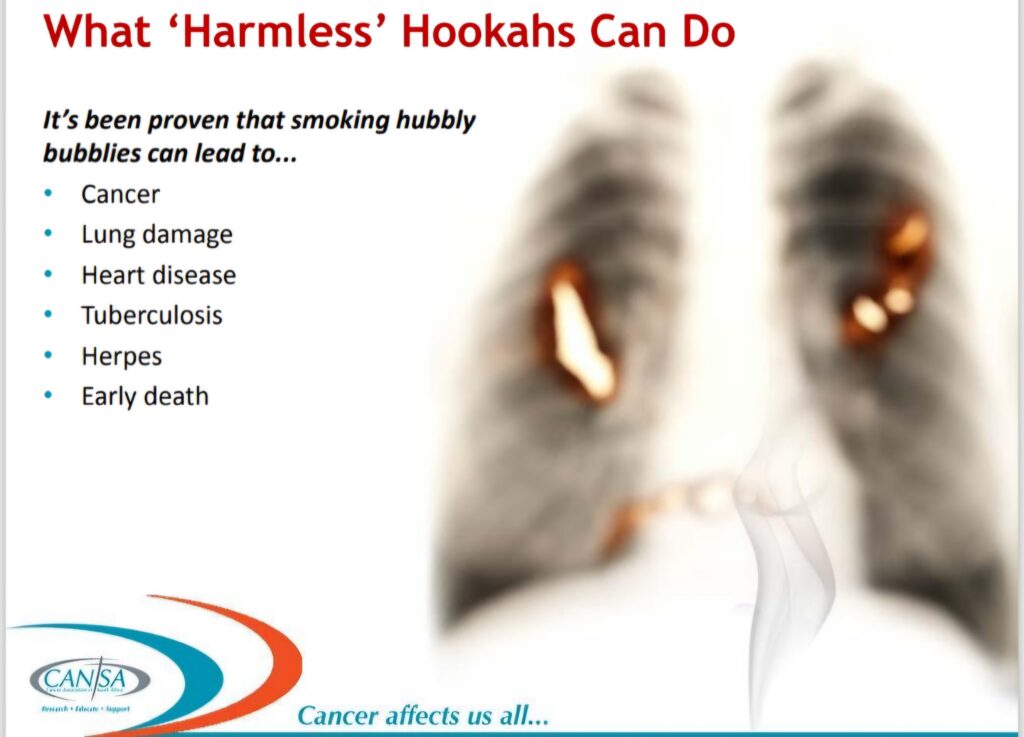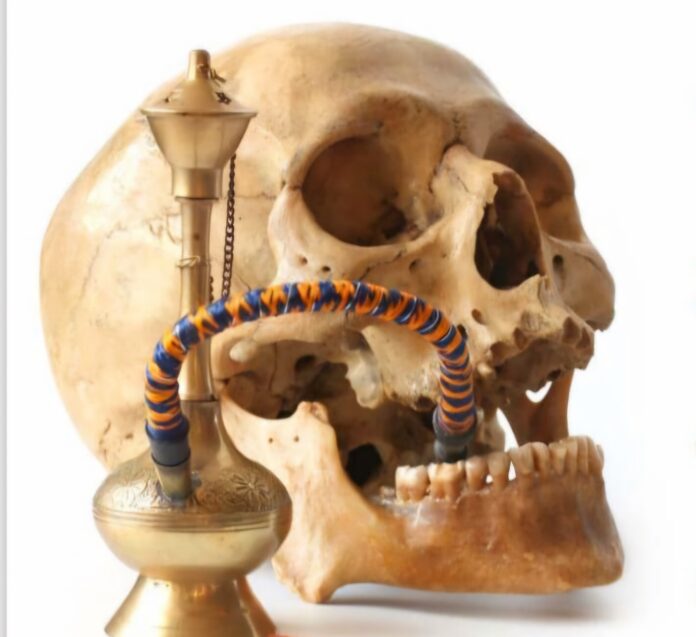*For the latest, compelling and inspiring South African news, visit NOWinSA!
North West, South Africa — hookah smokers might want to rethink their ill-informed, high-risk recreational choice this holiday season. This as the country tries to come to grisp with the unsettling events involving the owner of Hanscombe Haven holiday resort in the North West, Mark Hanscombe, who was brutally stabbed after a confrontation with guests over the use of hubbly bubbly on the premises.
The horrific incident has once brought to scrutiny not only the misconception of hookah smoking being less harmful than cigarettes, but how a substantial amount of young people continue to smoke it despite their knowledge of possible health risks — as indicated in this study involving university students in the Western Cape by Tobacco Induded Diseases (TID).
More accurately, it brought into question the psychological factors associated with hubbly bubbly, as it’s called in South Africa. Prove to this was a study examining its relationship to the level of aggressive behaviours of Arab students, be it anger, physical violence, verbal violence, hostility and violence.
The study confirmed that smoking in its various forms is considered a dangerous behavior that leads to aggressive behaviors. It goes further to allude that Hookah and smoking in groups is even more dangerous, as it exposes individuals to increased opportunities to follow dangerous behaviors – because of the groups’ influence on an individual – such as bullying, and worse still drug use.
The waterpipe tobacco’s popularity surge in recent years, particularly among schoolchildren as young as 13, as well as young adults, and women, highlights the need for heightened awareness around its myths, potential dangers, notably myriad of adverse health consequences attributed to shisha, as well as intervention strategies
Hookah; how it works, 9 reasons it’s dangerous
The waterpipe, largely known as hookah, shisha, narghile, hubbly bububbly in South Africa, is an instrument for smoking tobacco.
The tobacco, mixed with glycerine and flavorings (to mask the tobacco) among others, is placed in a bowl surrounded by burning charcoal; when the smoker inhales, air is pulled through the charcoal and into the bowl holding the tobacco concoction. The resulting smoke is bubbled through water, carried through a hose, and inhaled.
Given the misconception that hookah is no-less harmful than cigarettes, in this article we look at key reasons why this increasingly popular tobacco smoking habit is dangerous due to myriad of negative health effects, and why it should be discouraged by any means necessary.

- Harmful chemicals: Hookah smoke contains toxic substances, including carbon monoxide, tar, heavy metals, and carcinogens. The charcoal used to heat the tobacco adds even more harmful chemicals to the mix. Even more worrying is that hooker sessions typically last longer than smoking a cigarette—often an hour or more—leading to higher levels of smoke inhalation. Compared with a single cigarette, smoking hookah for one session is said to deliver 36 times the tar, 125 times the smoke, 2.5 times the nicotine, and close to 10 times carbon monoxide, according to several researches, notably from the University of Pittsburgh School of Medicine and another from the Cancer Association of South Africa.
- Nicotine addiction: While its important to note that comparing cigarettes to hookahs is not an apple-to-apple comparison, hookah tobacco contains nicotine, which is highly addictive. A single session – lasting 45 to 60 minutes – can expose users to as much nicotine as smoking multiple cigarettes; one study equates that to a pack of cigarettes, increasing not only the risk of addiction, but more severe negative health effects. Note, the levels of nicotine in hookah are extremely variable, depending on the type of tobacco used, with the three commonly used hookah tobacco being Mouassal, Jurak, and Tumbak.
- Contaminated air quality, leading to secondhand smoke: The smoke exhaled by hookah users and the smoke from the charcoal can harm people nearby. Secondhand hookah smoke contains many of the same harmful substances as direct inhalation. The contaminated air quality – in houses of hookah smokers – puts a significant number of individuals (non-users) at risk, especially those with existing pulmonary and cardiovascular disease. Children and pregnant women, and others with chronic diseases are also at under increased risk of infections.
- Risk of infections: Sharing a hookah pipe without proper hygiene can spread infectious diseases, such as oral herpes, tuberculosis, and respiratory infections – all which have been found to be common among users. A classic case involved a 20-year-old Swiss male, who presented at the emergency department with acute onset of febrile temperatures, a hemoptysis and a 3-month history of productive cough. An X-ray and CT scan revealed pulmonary infection with Mycobacterium tuberculosis. None of the classical risk factors for TB were present, and no known exposure to the disease, but the patient reported regularly smoking a water pipe, known to pose risk of MTB transmission. Taking it back to home, in January 2024, a concerning incident unfolded in Mahikeng, North West, where a patient named Bakang Rankokwa, 30, was left fighting for his life in the ICU for two weeks after suffering a stroke linked to smoking hubbly by the hospital medical doctors. An X-ray revealed that one of his lungs had a hole and was filled with water and blood, as reported in local media, including the SABC News.
- Misconceptions about filtration: The water in a hookah does not filter out harmful chemicals. Instead, it cools the smoke, making it easier to inhale deeply, which can lead to more damage to the lungs. This mean when smoking hookah, your body is easily absorbing in nicotine, tar, and heavy metals – over 4000 chemicals to be precise, 70 of which are known cancer causing carcinogens – including lead, benzene and arsenic.
- Respiratory, cardiovascular and cancer risks: Regular hookah use can lead to chronic respiratory diseases, such as bronchitis, as well heart disease due to exposure to carbon monoxide and other toxic substances. Hookah smoking is also associated with increased risks of oral, lung, stomach, and esophageal cancer due to the carcinogens in the smoke. Several scientific studies have indicated that smoking amplifies susceptibility to various types of cancer, such as esophageal, gastric, and lung cancers. One such a study was conducted to determine the relationship of hookah vs cigarette smoking to lung cancer in the Kashmir valley of the Indian subcontinent. The report shows that cigarette smokers had a 4.2 times risk of lung cancer compared to non smokers, while hookah smokers were nearly six times at risk for lung cancer as compared to nonsmokers — (PubMedstudy). Additionally, various respiratory conditions, including abnormal pulmonary function, emphysema, and chronic bronchitis, are among a plethora of health issues linked to it. So is cardiac ailments, notably ischemic heart diseases, along with osteoporosis, obstetrical and prenatal complications, periodontal diseases, and even liver afflictions such as hepatitis.
- Premature skin aging: The effects of smoking on premature skin aging has long been long-established by science. When you smoke, the toxins that enter you system dehydrate your skin and accelerate the process of skin aging by reducing collagen production and making your skin appear duller. Since smoking tobacco decrease the amount of oxygen that reaches the skin, your can skin lose elasticity, causing fine lines and wrinkles to show up much sooner. Furthermore, with a 60-minute hookah equated to smoking 40 to 400 cigarettes – with a typical hookah smoking session containing about 36 times more tar, and about 10 times more carbon monoxide than the smoke from a single cigarette – one can only imagine the kind of damage the former can do your skin health.
- Impact on Youth: Hookah’s flavored tobacco and social appeal make it especially attractive to young people, fostering early nicotine addiction and exposing them to harmful health risks. Simply put, hookah smoking is not a safe alternative to cigarettes. The health risks are substantial, and the social or cultural appeal should not overshadow the dangers it poses to individuals and those around them.
Furthermore, a 2024 study by the Mental health, Alcohol, Substance use & Tobacco Research Unit (published by SAMRC) found that the prevalence of hookah smoking among the university students was 31.5% (32.1% among males and 30.9% among females), blamed the rise on hookah marketing.The findings led to several recommendations, among them was that the government needs to urgently pass the Tobacco Products and Electronic Delivery Systems Control Bill of 2022. The recommendation seeked to strengthen tobacco control in the country including regulating hookah products in order to protect young people from being targeted by the manufacturers and marketers of these products.”There should be clearer graphic health warnings and plain packaging of hookah, e-cigarettes and cigarette products, these can assist to communicate the health risks associated with its use and may deter students from initiating use. The ban on tobacco advertising, promotion and sponsorship (one of six MPOWER measures) should be enforced for hookah products and urgently extended to cover e-cigarettes,” said Dr Cathrine Egbe
9. The law and (shisha) smoking in public spaces; maximum fine: Sisha smoking is governed by the smoke-free legislation in most parts of the world, including South Africa (SA Smoking Laws). The law was designed to protect citizens from the hazards of second-hand smoke, which is particularly dangerous for pregnant women, babies and childre, and those with chronic heart or lung conditions such as asthma.
Likewise, in South Africa, the law prohibits smoking in public places except in the portion of the public place prescribed by the Minister of Health. However, the regulations permit persons in control of workplaces, government facilities, as well as casinos and hotels to designate a smoking area, which may not exceed 25% of the total floor area. In the case of Hanscombe Haven Holiday Resort attack, the owner was well within his rights to prohibit the public use of hubbly bubbly within the resort premises.
As for those found to have breached the smoke-free law, the prescribed fine for the owner of a restaurant, pub, bar and workplace is a maximum of R50,000 and R500 for the individual smoker.

